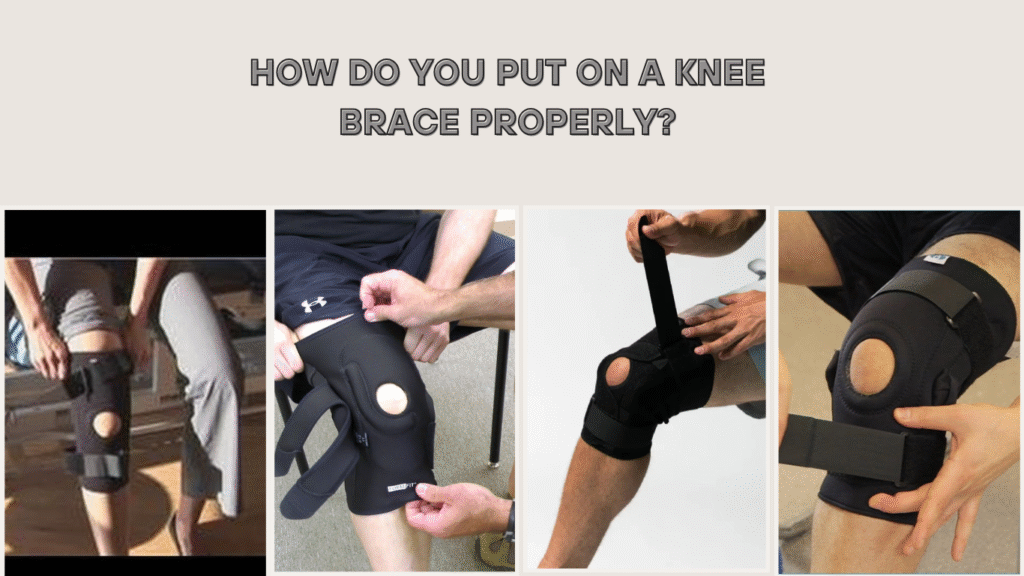
Learn how to put on a knee brace to ensure optimal support and comfort for your knees during their healing process.
A knee brace is essential for helping you stay active with minor to moderate knee pain and strains. As it turns out, wearing it incorrectly can cause irritation or even increased pain. This article is a complete guide on how to wear a knee brace properly, selecting the best orthosis you would need for your case, and how to get the right fit. We’ll also discuss some of the pitfalls to avoid so that you can get the most out of that knee support. With the correct know-how, you can be certain that your knee brace is working at its most efficient in helping you recover
A knee brace can really help with rehabilitation from injuries or pain relief for arthritis. Some injuries will appear more stable with one on, and you will actually feel like you can walk a little. But it is important to know how to wear a knee brace correctly. In this article, I will discuss everything about knee braces, from how to pick the right brace to how to adjust them to ensure a comfortable fit. We’ll also discuss a few things to avoid to get the most out of your brace.
How Do You Practice on a Knee Brace Properly?
Wear your knee brace the right way for maximum effectiveness. Start by sitting down in a comfortable position. Bend your thigh to nearly a 45-degree angle. It’s the angles on this angle that ensure alignment. Ensure the brace’s hinges are centered over the midpoint of your knee. The position is necessary for maximum support. When you strap on the knee brace, ensure it is tight but not excessively so; this guideline also applies to the straps during fitting. The right-fit knee brace should lend support without preventing blood flow.
How to Choose the Right Type of Knee Brace for Your Injury
There is a brace for each of these types of injuries. If you have a ligament injury, say an ACL or MCL tear, a hinged functional brace is best. This variety offers the most support and stability. But if the pain is not so severe, you may be better off with a compression knee support. If you have problems with knee alignment, look for a patellar stabilization brace. Each brace serves unique purposes. Knowing these uses is essential for optimal results.
Knee Sleeve vs. Knee Brace: What Is the Difference?
The knee sleeve is often mistaken for the knee brace. A knee sleeve is mostly built to provide compression and heat. It improves proprioception, the ability to feel where your knee is. It is something that can be helpful in sustaining health and avoiding injury when practicing sports. However, a knee brace primarily provides comfort and stability. It may also contain hinges and other devices adapted to lock the knee joint. Whether to choose the former or the latter depends a great deal on how serious your case is and how much support you require.
Looking for the Right Size: A Knee Brace Sizing Guide
Getting an accurate size is important to ensure your knee brace functions properly. Measure the diameter of your thigh and calf around the widest part. Then, look at the manufacturer’s sizing chart. With a snug fit, the brace should fit comfortably. It also needs to be free to move, but not slide up and down. And don’t forget an adjustable brace to help you fit the item to perfection as you recover or as the condition of your knee changes.
Most Common Knee Brace Errors and How to Avoid Them
Not using a knee brace properly may cause the device to be uncomfortable or provide insufficient support. One major mistake is overtightening the straps. This has the potential to restrict blood flow and cause pain that is not needed. Another error is not fitting the brace correctly. Make sure the hinges are centered over the center of your knee. Maintenance is also key. Inspect your brace for signs of wear and replace it as needed so it continues to provide support.
6. Adjusting Straps for Stability Without Cutting Off Circulation
The straps’ adjustment is critical in getting the fine tuning correct between stability and blood flow. Buckle first the strap that lies closest to your knee. It will be tight enough to provide the support required but should not constrict or cut off blood flow. You can do the two-finger test in this case. Slide two fingers under the strap, and if you can’t, it may be too tight. Be mindful of tingling or numbness in your lower leg, which can be a sign that you need to loosen the straps.
Is it OK to wear a knee sleeve all day? Here’s the Truth
How long you can wear a knee brace depends on its type and your particular condition. Most of the time, a compression is comfortable for daily wearing, even for those with limited movements. If, on the other hand, you’re wearing a knee sleeve that’s been recommended post-surgery, then it’s very important to respect what your doctor has told you. It can overtax muscles or create dependence on the support. A healthcare professional can provide tailored advice for your particular circumstances.
How to Keep Your Knee pad Clean and in Good condition.
Prolonging Your Knee Brace. You will want to clean your knee brace so it’s able to maintain its quality. Clean the brace with a gentle scrubbing with some mild soap and lukewarm water. Do not machine wash or put in the dryer, as heat can ruin the products. Let your brace air dry all the way before putting it on again. Regular inspections are also beneficial; check for any signs of wear, especially in the straps or hinges, and replace them as needed.
Signs That Your Brace Is Not Fitting You Correctly
You need to know when you have a knee brace that doesn’t fit. If you find a little slippage as you move, discomfort, or skin irritations, these are all cues that it’s time to make some changes. The splint fit may be too loose, too snug, or not properly aligned. The development of a bruise or numbness is also a sign telling you to rethink what size, fit, and position you’re using your brace in. A well-fitting knee brace will not hinder your movements and should not cause discomfort.
When to Consult a Doctor About Your Knee support
If pain is intensifying and a knee brace isn’t helping, it’s time to see a doctor. Rashes and open sores are also signs of skin breakdown, and a doctor should check them. If it still hurts, your brace may be ill-fitting or worn incorrectly. You should always talk to your doctor about your condition, and using the knee support is a key part of the conversation to ensure you’re recovering properly.
This book is a complete guide to applying a knee brace effectively. Remember that with the right information carried out, you can work to return to a pain-free lifestyle. If you’re recovering from an injury or if you live with the everyday discomfort of chronic pain, a properly fitted knee sleeve can be a superior asset.
FAQ
How to put a knee brace on correctly?
Have a seat and extend your leg. Position or slide the brace until it aligns with your kneecap. The straps should secure the brace snugly, starting from the bottom. Just ensure that it doesn’t fold or fall.
How do you know if your knee brace is on right?
Do the two-finger test: two fingers on the understraps should fit. If it slides, it’s too loose. If the brace tingles or restricts circulation, it’s excessively snug. It should be a sense of support, not pain.
Is a knee brace good for pain?
Yes, wearing a knee brace can help relieve pain by stabilizing the joint and taking some of the strain off ailing muscles. It’s beneficial for arthritis, sprains, and post-surgery recovery. Make sure you’re always matching the type of brace to your condition.
Should a knee brace be tight or loose?
Neither. The knee brace should be snug but not tight. If there are dents or it feels numb, it is too tight. Apply a little bit more pressure if it slips or spins. Consideration of Both Comfort and Support.
Is it OK to wear a knee brace all day?
You shouldn’t wear a knee brace all day unless your doctor specifically instructs you to. Some braces are intended for activity only, while others may be worn longer than a few hours. Please don’t wear the brace excessively, as it might weaken your muscles over time.
Can you sleep in a knee brace?
Doctors typically recommend against it. A circulatory disturbance or stiffness can result from sleeping with a brace. Unless instructed otherwise for injury recovery, you may use the brace during the day.

